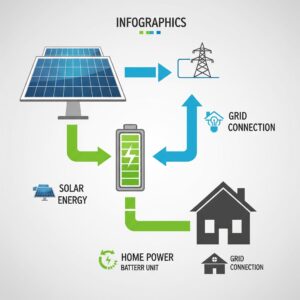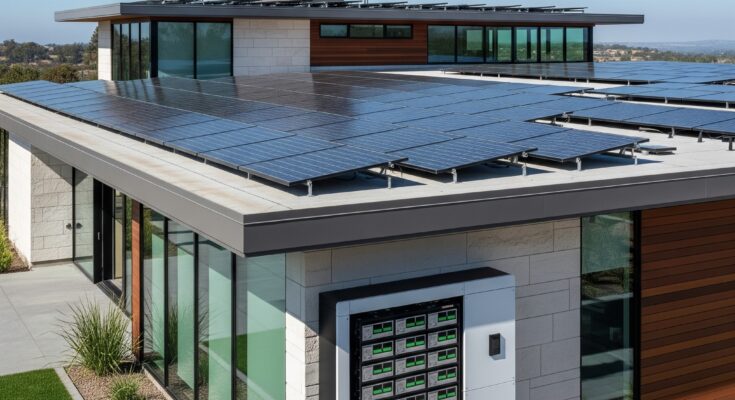The Future Is Bright: Anywhere, Anytime Solar Energy
Imagine living in a world where the sun provides all of the energy for your house, not only during the day but also at night and on overcast days. “Sun on Demand” technologies are making this exciting reality a reality, not just a far-off dream. Simple solar panels are giving way to integrated systems that intelligently distribute, store, and capture solar energy, transforming it into a consistent and dependable power source.
Beyond the Rooftop: How “Sun on Demand” Works.
“Sun on Demand” essentially outlines advanced solar energy systems that include three crucial components:
1:High-efficiency solar panels, which convert sunlight into electrical power, are the workhorses. Modern panels are more efficient and aesthetically pleasing than ever before.
2:Advanced energy storage that runs on batteries is where the “on demand” magic happens. During periods of maximum solar radiation, excess solar energy is stored.In batteries larger-capacity batteries. with a substantial capacity. batteries with a large capacity. hours of sunshine. When the sun isn’t shining, this stored energy can be used to maintain a steady supply of electricity.
Intelligent energy management systems monitor energy production, consumption, and battery levels:

They automatically optimize energy flow, deciding whether to use direct solar power, draw from the battery, or even connect to the grid for maximum efficiency and cost savings.
This sophisticated control ensures a seamless power supply, adapting in real-time to both energy demand and solar availability. Ultimately, these systems empower users with greater control over their energy consumption and expenditures.
The Advantages Are Educative
Adopting “Sun on Demand” has several significant benefits.
- Energy Independence: Lessen your dependency on conventional grid power to safeguard against power outages and growing electricity prices.
- Environmental Stewardship: Use a clean, renewable energy source to drastically reduce your carbon footprint.
- Financial Savings: Although the initial outlay may be substantial, it is a wise financial decision given the potential incentives and long-term electricity bill savings.
- Enhanced Home Value: Buyers are becoming more interested in homes with cutting-edge solar and storage systems.
- Grid Stability: By distributing energy resources and lowering peak demand, widespread use of these systems can contribute to the stabilization of the entire energy grid.
Do You Think “Sun on Demand” Would Work for You?
Are you considering setting up a “Sun on Demand” system at your home or workplace? The following are some things to think about:
- Sunlight Exposure: How much direct sunlight does your property receive each year?
- Energy Consumption: What is your typical electricity usage?
- Budget and Incentives: Investigate government rebates, tax credits, and local utility incentives that might be able to help cover installation costs.
- Reputable Installers: Choose knowledgeable and skilled professionals for both design and installation.
Resources to Look Into more on Sun on demand
Are you prepared to find out more and possibly make the move? The following resources are useful:
- Solar Information from the Department of Energy: https://www.energy.gov/eere/solar/solar-energy-technologies-office
- Solar Energy Industries Association (SEIA): https://www.seia.org/
- Consumer Guide to Solar Energy: https://www.consumerreports.org/solar-panels/
The sun is the source of the energy of the future, available whenever you need it. Join the movement toward a more sustainable and brighter future by embracing innovation!
Common Questions Regarding “Sun on Demand”
- What is “Sun on Demand” exactly?
“Sun on Demand” describes cutting-edge solar energy systems that combine intelligent energy management systems, large-capacity battery storage, and highly efficient solar panels to deliver a steady and reliable power source even when the sun isn’t shining. - What distinguishes “Sun on Demand” from conventional solar panels?
Electricity is mostly produced by conventional solar panels when the sun is not shining. “Sun on Demand” systems offer complete energy independence by storing excess energy and supplying power continuously through intelligent management and advanced battery storage. - What constitutes a “Sun on Demand” system’s essential parts?
Intelligent energy management systems, sophisticated energy storage (batteries), and high-efficiency solar panels make up the three primary parts. - How do “Sun on Demand” systems’ batteries operate?
Extra solar energy produced during the hottest parts of the day is stored in batteries. Your house or place of business is then powered by this stored energy at night, on overcast days, or during blackouts. - Describe the functions of an intelligent energy management system.
It automatically optimizes energy flow by tracking energy production, consumption, and battery levels. For optimal efficiency and cost savings, it chooses whether to connect to the grid, use direct solar power, or draw from the battery. - Can I get off the grid entirely with “Sun on Demand”?
Although it greatly lessens reliance on the grid, total removal is contingent upon your energy usage, system size, and local laws. Numerous systems provide the choice to sell extra energy or to stay connected to the grid as a backup. - What advantages does “Sun on Demand” have for the environment?
These systems significantly lower your carbon footprint and help create a more sustainable energy future by utilizing clean, renewable energy sources. - Is it wise to spend money on “Sun on Demand”?
Potential government incentives, tax credits, and long-term electricity bill savings make the initial installation cost—which can be high—a prudent financial choice. - Will adding “Sun on Demand” raise the value of my house?
Indeed, homes with state-of-the-art solar and storage systems are becoming more and more desirable to buyers, which could raise the market value of your property. - What role does “Sun on Demand” play in maintaining grid stability?
Widespread deployment of these systems can help stabilize the entire energy grid by distributing energy resources and reducing peak demand on centralized power plants. - How much direct sunlight does my property need to have a “Sun on Demand” system?
The quantity of direct sunlight your property receives annually is one of the most crucial factors in determining the efficiency and capacity needed for your solar panels. A qualified installer can conduct a site assessment. - How can I figure out how much electricity I use on average for system sizing?
You can accurately estimate your energy consumption by looking at past electricity bills, which is essential for appropriately sizing your “Sun on Demand” system. - Are there any government rebates or incentives available for “Sun on Demand” systems?
Many places offer government rebates, tax credits, and local utility incentives to help cover the initial installation costs. Investigating what is available in your area is crucial. - How can I locate a trustworthy “Sun on Demand” system installer?
Seek out competent and experienced experts who have a track record of successfully designing and implementing energy storage and solar systems. Verifying references and certifications is advised. - How long do the “Sun on Demand” components last?
The typical warranty for high-efficiency solar panels is 20–25 years, but advanced batteries can last up to 10–15 years, depending on usage and technology. - Can my house be powered by “Sun on Demand” systems in the event of a blackout?
Indeed, the integrated battery storage’s capacity to supply backup power during grid outages, guaranteeing the continued operation of your vital appliances, is one of its main advantages. - Is “Sun on Demand” limited to residential use, or is it also advantageous for businesses?
“Sun on Demand” systems can greatly benefit both residential and commercial properties by lowering operating costs and enhancing energy resilience. - What sort of upkeep is necessary for “Sun on Demand” systems?
These systems typically require little upkeep, mostly consisting of cleaning the solar panels on a regular basis and checking the inverter and battery system from time to time. - What is the average installation time for a “Sun on Demand” system?
After initial planning and permitting, installation times usually range from a few days to a couple of weeks, though they can vary depending on the property and the complexity of the system. - Where can I learn more about the technology known as “Sun on Demand”?
Consumer advocacy groups, solar industry associations (like SEIA), and government energy departments (like the Department of Energy) are all trustworthy sources.




